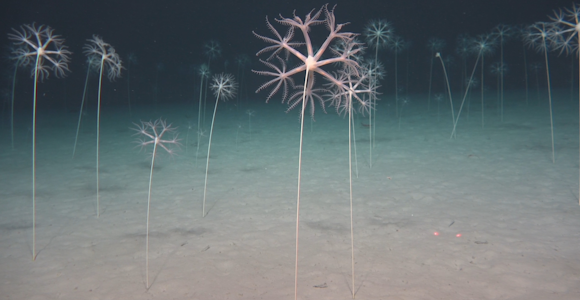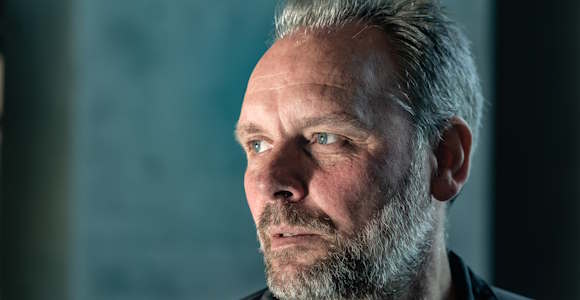
After 50 Expeditions, Ronnie N. Glud is Rewriting Deep-Sea Science
Professor. Deep-sea explorer. Adventurer in the ”dark”. Ronnie N. Glud has explored some of the most remote and deepest parts of the ocean. He now knows that the dark, cold depths are far less barren and isolated than we once imagined.
“Oh… well, I guess we must go all the way back to my childhood,” says Ronnie N. Glud when asked where his fascination with the deep sea began.
From an early age, nature had him hooked. He kept aquariums, birds, and terrariums, loved fishing and hiking in the woods, and devoured books about explorers and blank spots on the map. Curiosity drove him then—and it still does. What’s waiting around the next corner?
That curiosity led him to study biology at Aarhus University, which in turn took him across the world to explore aquatic environments of all kinds: tropical coral reefs, fjords, rivers, lakes, coastal waters, mangrove swamps, sea ice, the polar ocean, and the open ocean. Eventually, it pulled him downward—into the deep sea. Today, Glud leads the internationally renowned research center HADAL, funded by the Danish National Research Foundation.

Why is the deep so important?
Throughout his career, Glud has contributed to numerous novel insights—but his most groundbreaking discoveries have come from the hadal depths.
“There’s much more going on in the deep, than we thought when I first entered this research area,” he says, referring to nearly two decades of research that have reshaped our understanding of the deepest ocean.
But before diving into those revelations, Glud wants us to understand why the deep sea is so important and why the hadal realm is so relevant to study. Technically, the hadal zone refers to parts of the ocean deeper than six kilometers, and it is named after Hades, the Greek god of the underworld.
Mercury and PCB in several deep trenches
“The deep sea covers 60% of the planet and is absolutely critical to how Earth works,” Glud explains, “Deep Sea processes regulate the climate, energy balances, and chemical conditions on Earth. So, if we want to understand how the planet responds to climate change and biodiversity, we need to understand the functions of the deep ocean.”
To date, Ronnie N. Glud has been on 51 scientific expeditions. In recent years, these journeys have taken him to some of the world’s most remote and inaccessible places, including the Challenger Deep in the Mariana Trench (10,911 m), the Kermadec Trench (10,047 m), the Atacama Trench (8,065 m), the Aleutian Trench (7,822 m), and the South Sandwich Trench (8,202 m). Each expedition has added new insights into the mysteries of the deep.
“We now know that deep-sea trenches aren’t as disconnected from the rest of the world as we once thought. What happens on land and at the surface affects even the deepest parts of the ocean,” he says. “For example, we’ve found surprisingly high concentrations of pollutants like mercury and PCBs in several deep trenches. That was a real eye-opener. People consider the deep sea as unaffected by human activity, but it’s not.”
From melted nuclear reactors
And mercury and PCBs aren’t the only intruders.
“In the 9,5 km deep Japan Trench, we found unstable cesium isotopes that could only have come from the melted reactors at the Fukushima nuclear power plant that had been destroyed just four months earlier by a tsunami. It shows just how fast material from land and coastlines can travel to the ocean’s greatest depths. Likewise, we observe a strong link between surface ocean productivity and biological activity at extreme depths. This means that climate-related or human-induced changes in the surface ocean can quickly affect even the deepest parts of the marine environment.”
There are 27 known deep-sea trenches on Earth. They are on average just 70 kilometers wide, but many are thousands of kilometres long. They do, however, only represent a tiny fraction of the global seafloor. Still, about 20 years ago, Glud began to suspect these narrow zones might contain more material and be more important than previously believed.
The idea that grew into a hypothesis
The idea came from his work in deep fjords, where central basins often held much more sediment than surrounding seabeds.
“It’s like a basement stairwell—it’s where dead leaves and old candy wrappers end up. Material accumulates in the deepst areas over long timescales. That observation made me think the same might apply at a larger scale. That’s when I started focusing on deep-sea trenches.”
A major turning point came in 2016 when Glud received a five-year grant of nearly DKK 24 million (approx. €3.2 million) from the European Research Council, enabling him to establish a research center and embark on his trench expeditions. In 2020, the Danish National Research Foundation followed up with DKK 54.6 million to fund the HADAL center at SDU.

Ronnie N. Glud
-
Head of the Danish Center for Hadal Research (HADAL).
-
Ph.D., D.Sc., and Professor of Biogeochemistry and Microbial Ecology at the Department of Biology, Danish Institute for Advanced Study, and Tokyo University of Marine Science and Technology (20%).
-
Before being recruited as a globalization professor to SDU in 2010, he studied and conducted research at Aarhus University, the University of Copenhagen, the Max Planck Institute in Bremen, and the Scottish Association for Marine Science.
-
Glud investigates the effects of climate change in the ocean, with a particular focus on the deepest parts of the sea. He has also developed several sensors and autonomous instruments for deep-sea exploration.
-
Member of the Royal Danish Academy of Sciences and Letters. He has published more than 250 well-cited scientific articles.
-
His research is supported by the European Research Council and the Danish National Research Foundation, among others.
Since then, Glud and his HADAL colleagues have published a series of high-impact studies. Among their findings: the world’s trenches store disproportionate amounts of carbon. Organic matter sinks from the ocean surface and slides down trench walls—or gets dumped in large underwater landslides triggered by earthquakes.
“Our early calculations show that a single square meter of trench can sequester 70 times more organic carbon than an average spot in the deep sea,” says Glud. “So even though trench areas are relatively small, they contribute significantly to the ocean’s storage of CO₂ in the form of organic carbon.”
Not all of this organic matter is buried, though. Some of it becomes food for animals and microorganisms that thrive under extreme pressure in total darkness.
Many different microbes
“There’s much more microbial activity at depths than we expected. Normally, biological activity declines with increasing water depth. But in the trenches, activity begin to increase again—because the organic material is focused at the trench axis , supporting life in the dark.”
And life is surprisingly diverse:
“We thought we would find just a few ultra-specialized microbes able to exist under the extreme pressure,” Glud says. “Instead, we find many different microbial species. The large microbial biodiversity at the great depth suggest that microbes can adapt to extreme pressure much more easily than higher life forms.”
What the submersible found
His most recent expedition—to the Puysegur Trench south of New Zealand—brought yet another surprise. Led by a Chinese research team from the Institute of Deep Sea Science and Technology, the mission used the world’s most advanced deep-sea submersible, Fendouzhe, capable of diving beyond 10,000 meters.
On several dives during the expedition, scientists discovered rich ecosystems built around microbial communities that feed on methane seeping from the seabed.
“These microbes use methane as an energy source in a process called chemosynthesis to produce biomoass, similar to photosynthesis but without sunlight. So even if the sun would expire, these communities would survive—at least until Earth runs out of oxygen,” Glud explains.
“I was stunned”
Few submersibles can carry more than three people, and they’re rare, so seats are highly coveted. As a lead researcher, Glud is often offered a place on these expeditions—but...
“Unfortunately, I’m claustrophobic, so I always politely decline. I can’t even stand being in a broom closet,” he laughs. “Instead, I stay onboard and eagerly wait for evening to come – where we jointly watch the daily dive footage. On the latest expedition, I was stunned— by the large biological communities powered by chemosynthesis at these large depths. That’s a discovery that will draw attention in the years ahead.”
The next planned expeditions won’t include submersibles—but researchers will still retrieve samples and measurements from the depths using sampling instruments and autonomous robots capable of collecting data and performing experiments far below the surface.
What’s waiting around the next cormer?
These missions aim to answer some important remaining questions: What processes drive material deposition in the deep? How do microbial communities adapt so rapidly to such extreme conditions? How is the deposited material decomposed? How diverse are the microbial communities across various trenches—and what drives the variation in life forms in the respective trenches?
Upcoming and already planned expeditions will visit The Molloy Deep in the Greenland Sea, The Kermadec-Tonga Trenches in the southwestern Pacific, The Japan Trench, and The Izu-Bonin Trenches in the northwestern Pacific
What’s waiting around the next corner?
Deep-sea research at SDU
Danish Center for Hadal Research is a basic research centre based at SDU. The centre explores life and biogeochemical cycles in the deepest pars of the world ocean.